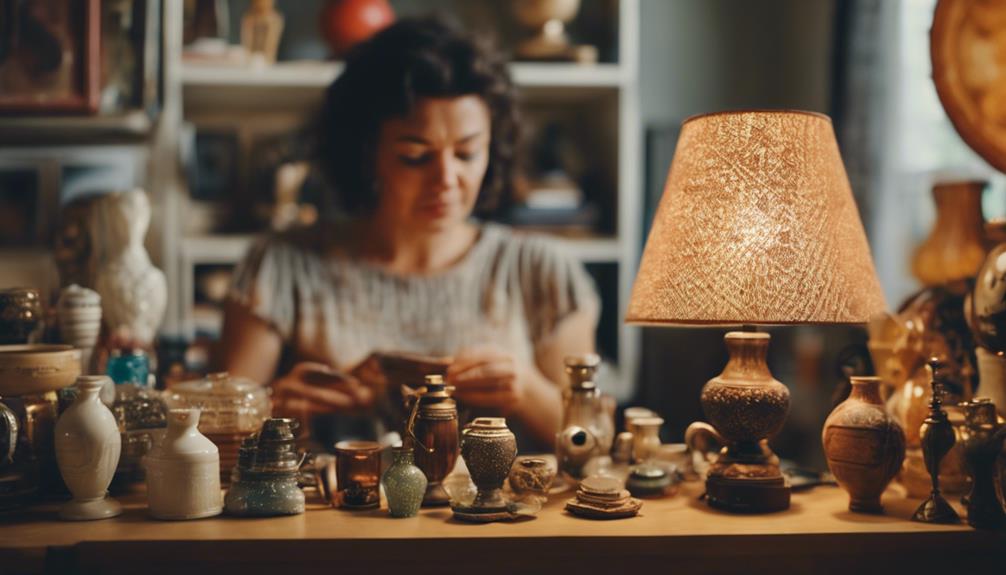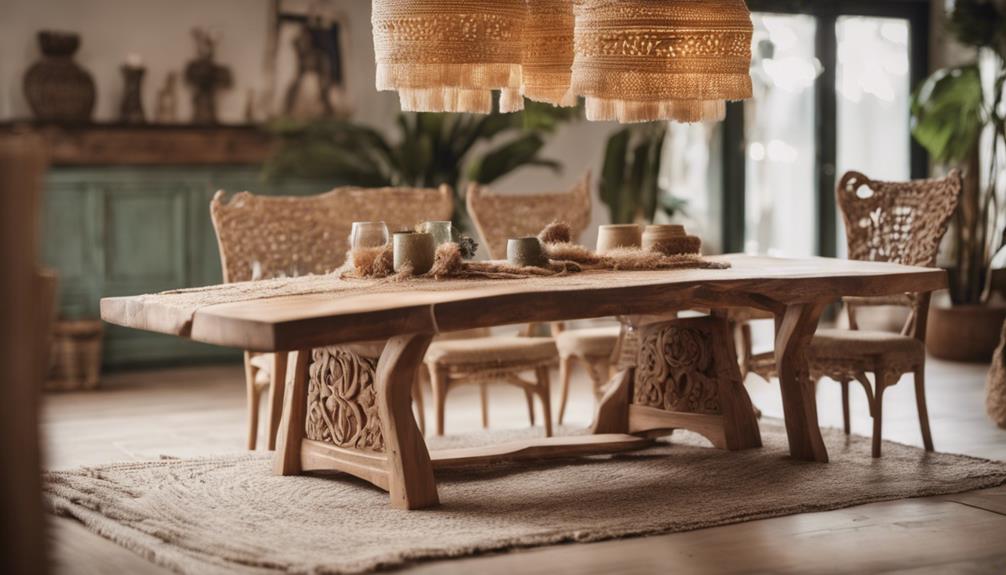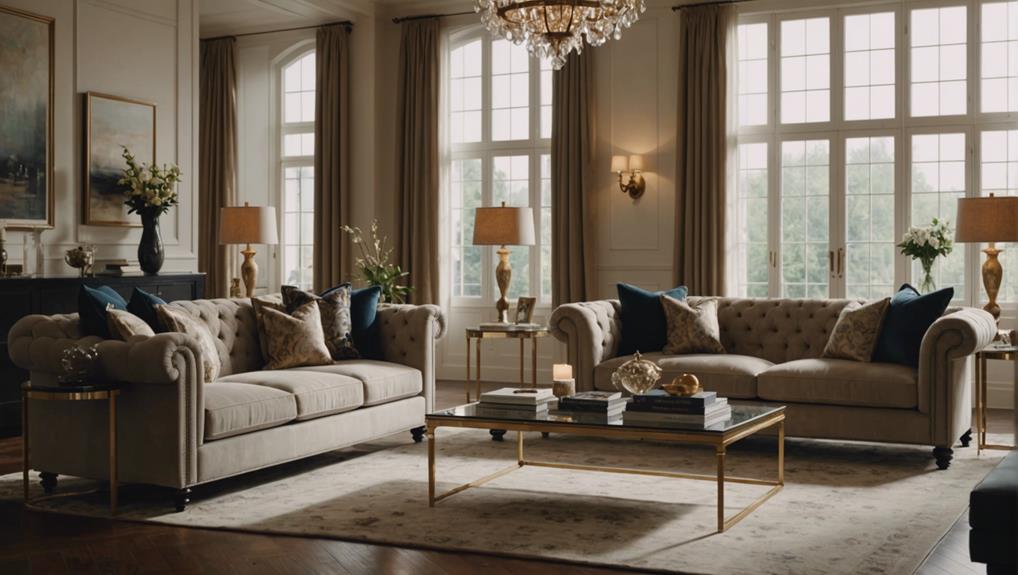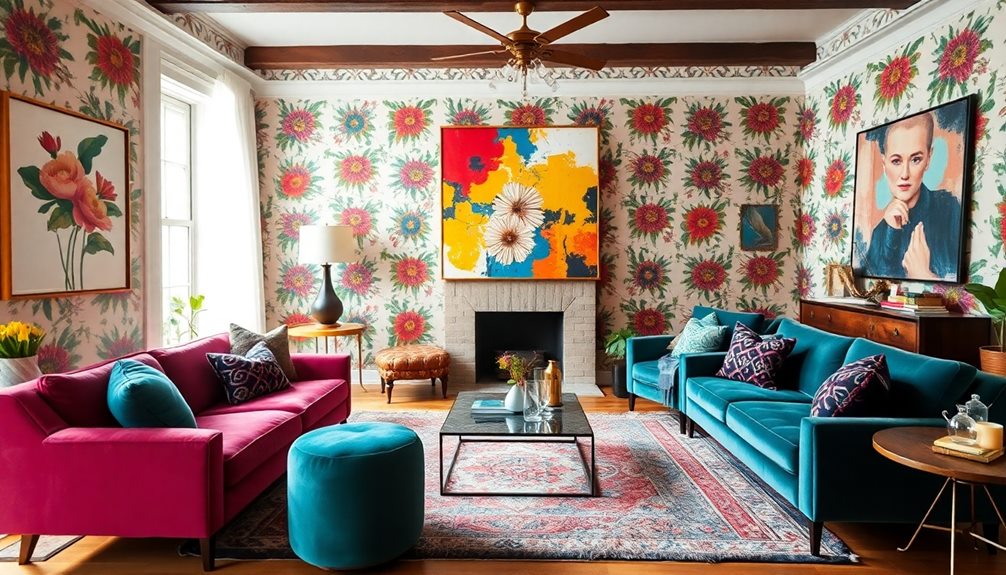In today’s market, home decor is becoming more expensive due to increasing material costs, disruptions in the supply chain, higher production expenses, and limited resources. Material prices have gone up, especially for wood, stone, and tiles, resulting in higher import and manufacturing costs. Global logistics issues and rising energy costs are also contributing to the overall price hike. Handmade items do not benefit from mass production savings, and the use of quality materials and fair wages for artisans further add to the expenses. To manage costs effectively, home decor enthusiasts can consider cost-effective alternatives such as thrifting, upcycling, and sustainable practices. Stay tuned for more insights on this intricate industry.
Key Takeaways
- Rising material costs, including wood, stone, and tiles, have surged by 30-40% since 2019.
- Supply chain disruptions lead to increased transportation costs, raw material shortages, and manufacturing delays.
- Higher production expenses for handmade items due to quality materials, fair wages, and meticulous craftsmanship.
- Limited resources and energy costs contribute to material scarcity and higher production expenses.
- Global supply chain disruptions and soaring energy costs impact material availability and manufacturing expenses.
Rising Material Costs
With material prices soaring, the cost of home decor items has seen a notable increase of 30-40% since 2019. The higher cost is primarily driven by the escalating prices of materials such as wood, stone, and tiles. Wood costs have surged due to increased import and manufacturing expenses, making it a pricier option for home decor products. This rise in prices isn't limited to wood; imported stone and UK-worked tiles have also become more expensive, further contributing to the overall price hike in home decor.
These increases in material costs have a direct impact on consumers, as suppliers pass on these higher expenses. As a result, individuals looking to decorate their homes are faced with steeper prices for various decor items. The market for kitchen materials has especially felt the strain of these rising costs, with global suppliers shrinking and materials becoming harder to source at lower prices. Overall, the surge in material prices has notably influenced the affordability of home decor items, making it a more expensive endeavor for consumers.
Impact of Supply Chain Disruptions

Global supply chain disruptions have greatly impacted the pricing of home decor items due to increased transportation costs and shortages in raw materials. These disruptions have forced businesses to make adjustments that ultimately affect consumers at the checkout.
Here are some key points to ponder:
- Rising transportation costs: With disruptions in global logistics, the cost of shipping home decor products has surged, leading to higher price tags for consumers.
- Shortages in raw materials: Scarce resources like wood and textiles have driven up production expenses, impacting the overall cost of home decor items.
- Manufacturing delays: Supply chain issues have caused delays in production and shipping, creating bottlenecks that contribute to the higher prices consumers see.
- Complexities in sourcing: Fluctuating exchange rates and trade restrictions have added layers of complexity to the supply chain, making it harder for businesses to maintain competitive pricing while upholding craftsmanship and attention to detail.
Higher Production Expenses

The impact of supply chain disruptions on home decor prices has highlighted the significant role that higher production expenses play in the overall cost of handmade items. Skilled artisans invest years honing their craft, resulting in meticulous attention to detail that minimizes mistakes but adds to production costs.
Unlike factory production, handmade items lack the cost-saving benefits of large-scale manufacturing, leading to higher per-unit expenses. Additionally, the use of quality materials, such as high-grade natural resources, further contributes to the price of handmade home decor.
Furthermore, an ethical commitment to providing fair wages for artisans involved in the production process adds another layer to the expenses incurred. These factors collectively drive up the prices of handmade home decor, reflecting the dedication and expertise of the artisans behind each unique piece.
Limited Resources and Energy Costs

Limited resources, such as high-quality materials, can have a substantial impact on the cost of home decor items.
Additionally, the rise in energy costs plays an important role in driving up production expenses for these products.
When certain materials become scarce, manufacturers face challenges that often result in higher prices for consumers.
Material Scarcity Impact
As we navigate the challenges of material scarcity and escalating energy costs, the home decor industry is grappling with soaring prices and supply chain disruptions.
Limited resources such as timber and stone are becoming scarcer, leading to increased material costs.
Rising energy expenses are impacting manufacturing costs, contributing to the overall high prices of home decor items.
Global supply chain disruptions are exacerbating material scarcity, affecting the availability and pricing of essential resources.
Suppliers in the UK are experiencing closures due to surging energy costs, further intensifying the scarcity of materials for home decor.
Rising Energy Expenses
Coping with the challenges posed by material scarcity and escalating energy costs, the home decor industry is experiencing a significant impact on prices and supply chain operations.
The rise in energy expenses has led to increased manufacturing costs for home decor products, ultimately affecting their retail prices. Limited resources coupled with higher energy costs have put pressure on suppliers, with some facing closures due to the financial strain.
This global trend is shrinking the pool of available suppliers, creating a ripple effect on the availability and pricing of materials essential for home decor. As energy expenses continue to climb, manufacturers are forced to make tough decisions to adapt to these financial challenges, ultimately influencing the overall cost of home decor items in the market.
Seeking Cost-Effective Strategies

To save money on home decor, we can explore creative and budget-friendly strategies that still reflect our personal style and taste. Here are four cost-effective ways to make the most of your home decor budget:
- DIY Projects: Engage in DIY projects to personalize your space without breaking the bank. From creating wall art to refurbishing furniture, DIY allows you to add unique touches while saving money.
- Thrift Shopping: Explore thrift stores, garage sales, and online marketplaces for hidden gems at affordable prices. You can find pre-loved items that can be upcycled or used as is to enhance your home decor.
- Repurpose and Upcycle: Give old items a new life by repurposing them for different functions or upcycling them into trendy pieces. This not only adds character to your decor but also reduces costs.
- Shop Seasonal Sales and Clearance: Keep an eye out for seasonal sales, clearance events, and discount codes from home decor stores. Timing your purchases strategically can help you save a lot on quality items for your home.
Sustainable Practices in Home Decor

Exploring sustainable practices in home decor aligns with our commitment to reducing environmental impact and supporting ethical production methods. Sustainable home decor prioritizes eco-friendly materials and production methods to minimize harm to the environment.
Artisans often utilize renewable resources and recycled materials in creating sustainable home decor items, promoting responsible consumption and a more environmentally conscious lifestyle. These products are designed to be durable and long-lasting, reducing the need for frequent replacements and contributing to a more sustainable way of living.
Additionally, ethical labor practices and fair wages are commonly observed in the production of sustainable home decor, ensuring that workers are treated fairly. By incorporating sustainable practices in home decor, we can make choices that not only enhance the aesthetics of our living spaces but also align with our values of environmental stewardship and ethical consumption.
Alternative Sourcing Methods

When it comes to finding cost-effective sourcing options for home decor, we can explore:
- DIY projects
- Upcycling materials
- Thrifting or buying secondhand items
These alternatives can't only help us save money but also add a unique touch to our decor. By considering these options, we can create a stylish home while being budget-conscious.
Cost-Effective Sourcing Options
Exploring unique decor pieces through direct artisan sourcing can offer budget-friendly and personalized options for home decor. To save costs and add a personal touch to your space, consider the following cost-effective sourcing options:
- Buying directly from artisans or local craftsmen: Support local talent while finding unique pieces at affordable prices.
- Shopping at thrift stores, estate sales, and online marketplaces: Discover one-of-a-kind decor finds without breaking the bank.
- DIY projects using reclaimed materials or upcycling: Create personalized decor items on a budget while reducing waste.
- Renting furniture or decor items for special occasions: Save money compared to purchasing for temporary needs.
DIY and Upcycling
To continue our discussion on cost-effective sourcing options for home decor, let's now shift our focus to DIY and Upcycling as alternative methods for finding unique pieces at affordable prices.
Upcycling involves repurposing old items into new, stylish decor pieces, reducing costs and promoting sustainability in home decor. DIY projects allow individuals to create unique decor items at a fraction of the cost of buying new, providing a creative outlet while saving money.
Alternative sourcing methods like thrift stores, garage sales, and online marketplaces offer budget-friendly options for finding quality home decor pieces. Repurposing furniture and accessories through DIY techniques like painting, reupholstering, or refurbishing can transform the look of a space affordably.
DIY and upcycling not only save money but also add a personal touch to home decor, making spaces more meaningful and unique.
Thrifting and Secondhand
Have you considered the benefits of thrifting and buying secondhand for your home decor needs? When it comes to interior design, thrifting and secondhand shopping can be game-changers. Here are four reasons why these alternative sourcing methods are worth exploring:
- Savings: Thrifting and buying secondhand decor items can save up to 80% off the retail price.
- Unique Finds: Secondhand stores offer a wide range of unique and vintage pieces at affordable prices.
- Access to Variety: Resale platforms like eBay and Facebook Marketplace provide access to pre-loved home decor at discounted rates.
- Sustainability: Buying secondhand reduces waste and promotes sustainability by giving items a second life.
Consider incorporating thrifting and secondhand shopping into your home decor strategy for budget-friendly options that don't compromise on style or quality.
Navigating High Prices in Industry

As we face the rising costs in the home decor industry, our approaches for managing these high prices must evolve to guarantee sustainability and value for consumers. With materials prices soaring by 30-40% since 2019, the overall cost of home goods has notably increased.
Wood, a fundamental material in home decor, has seen a spike in costs due to higher import and manufacturing expenses. Additionally, UK-based suppliers are grappling with closures driven by escalating energy costs, impacting the availability of materials for home decor items. The shrinking global supplier base has particularly affected the kitchen market, leading to higher costs for materials sourcing.
The expensive nature of home decor is further compounded by the elevated costs of imported stone and UK-worked tiles. To navigate these challenges, consumers can consider design tips that prioritize longevity and quality to maximize the value of their purchases amidst the current industry landscape.
Challenges Faced by Interior Designers

Interior designers face formidable obstacles when maneuvering through the current landscape of the home decor industry. The challenges encountered include:
- Rising Material Costs: With a significant increase of 30-40% in material costs since 2019, interior designers are finding it harder to stay within project budgets.
- Surging Wood Prices: Higher import and manufacturing expenses have led to a surge in wood prices, impacting the affordability of decor items for interior design projects.
- Closure of UK-Based Suppliers: Escalating energy costs have forced many UK-based suppliers to close down, limiting the availability of materials for interior designers to choose from.
- Shrinking Global Suppliers: The reduction in global suppliers is affecting the kitchen market and materials availability, contributing to the overall increase in costs for interior designers.
Navigating these challenges requires adaptability and creativity to make sure that clients receive quality room decor while managing the escalating material costs.
Frequently Asked Questions
How Much Does the Average Person Spend on House Decor?
We spend about $2,200 a year on home decor in the US. Millennials, on average, allocate $1,500 yearly for decorations. Homeowners budget around 10-15% of their home expenses for decor.
Renters typically spend $200-$500 annually on decorations. The total annual spending on home decor in the US exceeds $300 billion.
Why Is Room Decor so Expensive?
Room decor is expensive due to factors like artisanal craftsmanship, limited production, and premium materials. Artisans invest time, skill, and attention to detail, resulting in high-quality, exclusive pieces. Paying fair wages for ethical labor practices adds to the cost.
Sustainable practices and superior materials guarantee longevity and beauty but also increase expenses. Customization, originality, and a focus on quality contribute to the overall price of home decor.
Who Spends the Most on Home Decor?
We spend the most on home decor, with affluent individuals prioritizing quality and luxury items. Millennials also heavily invest in personalized and unique pieces.
Urban homeowners allocate more budget due to higher living costs and trends. Online shopping accessibility has influenced spending patterns. High-income households tend to splurge more on decor, showcasing a preference for premium products over budget-friendly alternatives.
These trends contribute to the overall expenditure on home decor.
What Makes House Looks Cheap?
When a house looks cheap, it's often due to low-quality materials, lack of uniqueness, poor craftsmanship, wobbly furniture, and cluttered spaces. Materials like particle board and plastic can make a home feel less upscale. Mass-produced items may lack character, while poorly assembled furniture can give off a shoddy vibe. Clutter and dated accessories can also detract from the overall aesthetic.
How can we elevate our home's look without breaking the bank?
Conclusion
To sum up, the high cost of home decor can be attributed to rising material costs, supply chain disruptions, production expenses, limited resources, and energy costs.
To navigate these challenges, seeking cost-effective strategies, incorporating sustainable practices, and exploring alternative sourcing methods are essential.
Despite the challenges faced by interior designers, it's important to adapt and innovate in order to meet the demands of the industry.
Remember, Rome wasn't built in a day, and neither is a well-decorated home.










